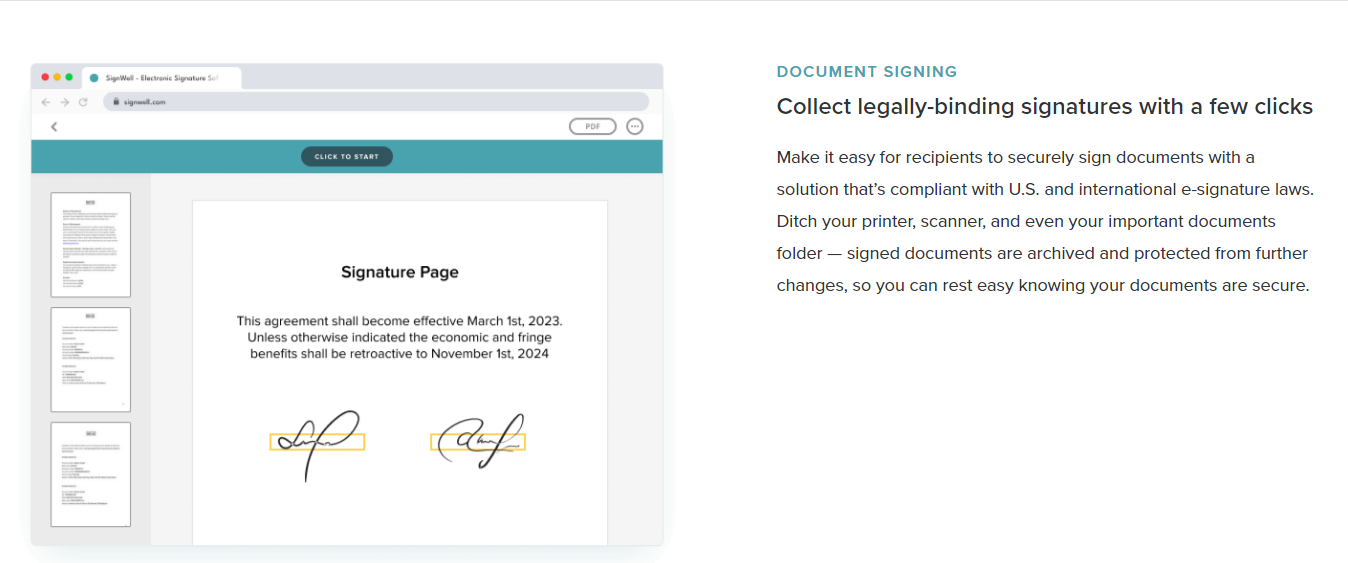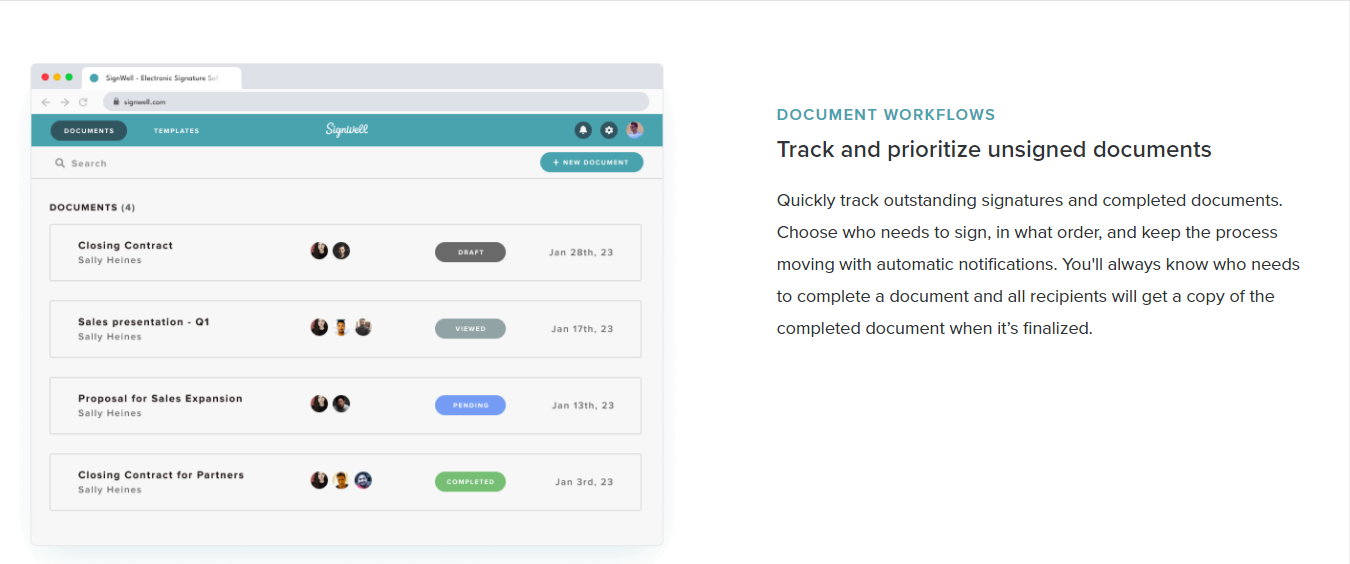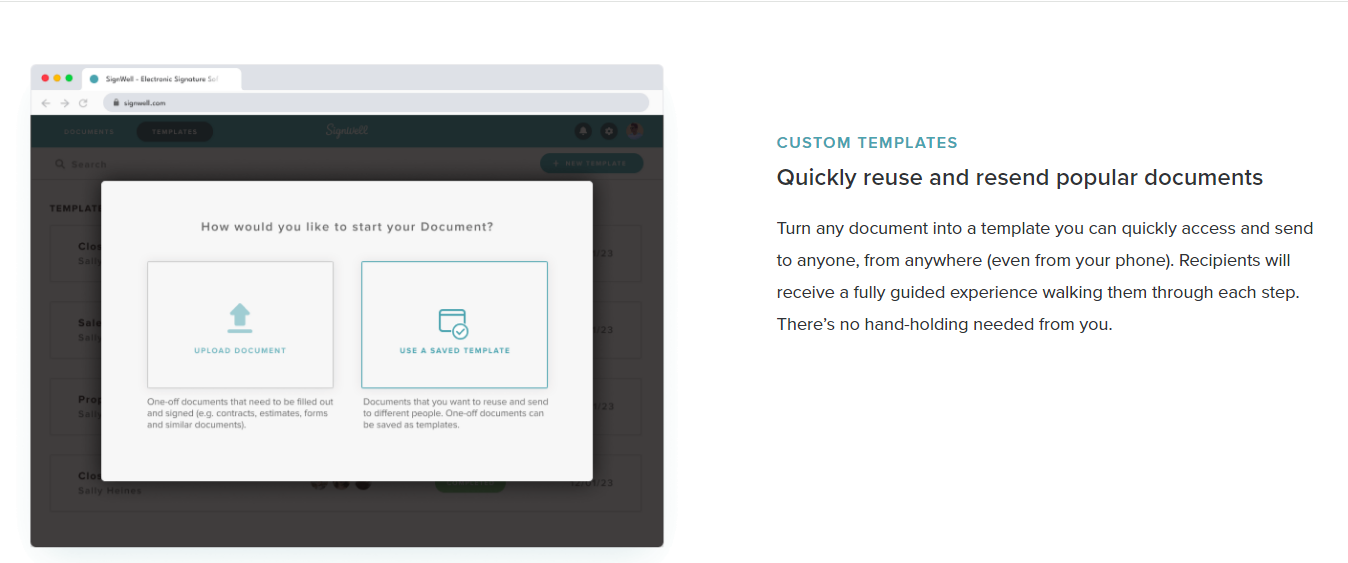Helpful Summary
- Overview: We discuss the legal validity of typed signatures, explaining their legitimacy under various international laws and the proper usage to ensure legal compliance.
- Why you can trust us: With over 61,000 businesses served and 4,000,000 documents processed, SignWell is a trusted expert in helping businesses create legally compliant electronic signatures.
- Why it matters: Typed signatures are convenient, efficient, cost-effective, and environmentally friendly.
- Action points: Follow legal standards, establish clear intent, and use a reputable platform like SignWell.
- Further research: Explore the SignWell blog for additional resources on electronic signatures and their legal validity.
Want to Know if Typed Signatures Are Legal?
Signatures are unique symbols or marks we use to represent our identities and give consent to contracts and agreements.
But they are not what they were. Modern business practices have changed how we sign. Now, we have different acceptable forms of signatures.
However, a question that often arises in the minds of people who sign digitally is—“Are typed signatures really legal?” This question is frequently asked, probably because typed signatures look too simple to be legal.
Not to worry, we’ll clear the air in this article. We’ll discuss how to make legally acceptable typed signatures. We’ll also explore the importance of leveraging platforms like SignWell for legally valid typed signatures.
But first…
Why Listen to Us?
We’ve helped over 61,000 businesses create legal electronic signatures.

Having processed over 4,000,000 signed documents, we can say we’re experts at helping people create all forms of electronic signatures, including typed signatures.
Our signatures adhere to strict international standards, making them legally binding in almost all jurisdictions.
What Are Typed Signatures?
Typed signatures are a form of electronic signature where you type your name or a unique mark into a document to indicate agreement or approval.
In simple terms, typed signatures are a way to agree to a document without signing on paper. A typed signature usually involves typing your full name, initials, or a phrase that represents your consent.
Most times, typed signatures are accompanied by date and time stamps to provide context and verification.
Typed signatures are commonly used to sign emails, online forms, and applications, as well as for digital contracts and electronic documents such as Word files and PDFs. They serve as a convenient and professional way to authenticate various types of correspondence and agreements.
Are Typed Signatures Legally Binding?
The answer is… it depends. Not especially satisfying, we know. However, there simply isn’t a clear answer as it varies from country to country and state to state.
Typed signatures can be legally binding in almost all jurisdictions. Most countries have adopted e-signature legislation that recognizes digital signatures as legally binding. This includes typed signatures, as long as they meet certain requirements.
For example:
- ESIGN Act & UETA (United States)
- eIDAS Regulation (European Union)
- ESL (China)
- The E-Signature Act (Japan)
- PIPEDA (Canada)
However, simply typing your name on a document is legally uncertain under pretty much all of these regulations. Signatures need to meet specific requirements under each of these regulations, like:
- Intent
- Consent
- Identity authentication
- Audit trail
- Timestamping
The specifics vary, but these themes are consistent. So, we can safely say that if your typed signature meets these requirements, it’s probably legal.
What Do You Need to Create Legally Binding Typed Signatures?
To create legal typed signatures, you need the following:
- A legally compliant document: The contract or agreement to be signed must follow applicable laws.
- Identity validation: Ensure there’s a way to validate the identity of the people signing.
- A signing method: Agree on a method of capturing the signatures. For example, using an electronic signature platform like SignWell is often a more secure signing method.
Benefits of a Typed Signature
Convenience
Parties can sign documents from anywhere in the world. All they need is a computer or smartphone. They’re free from the stress of signing on paper, printing, scanning, mailing, and other manual signing activities. This ability to sign instantly and remotely is the major advantage of a typed signature.
Efficiency
Typed signatures are created quickly, saving time for all parties involved. All manual signing activities are eliminated.
Also, the signing process is automated, ensuring the document is signed in the correct order and without delay. This streamlined signing process reduces delays in business transactions, boosting efficiency.
Cost-efficiency
One of the best arguments for typed signatures is to reduce operational costs. Typed signatures reduce the need for paper, ink, pens, shipping, and physical storage.
Environment-friendly
Typed signatures promote paperless transactions. Decreased demand for paper helps in forest conservation. Likewise, energy consumption is lessened as printing, copying, and transportation of physical documents are reduced. This lowers carbon footprints and protects the environment.
How to Make Your Typed Signatures Legally Valid
Establish Intent to Sign
For an e-signature to be legally valid, clear intent must be established. This means whoever is signing is doing it intentionally and acknowledges the terms and conditions of the document.
To establish intent to sign, the document must be clear and accessible to the signer. Legal jargon and complex language must be avoided. The terms and conditions must be straightforward and easily understood by the signer.
The intent to sign is required by law and protects the integrity of the transaction and the interests of the parties involved.
Get Clear Consent
Before having someone sign a document electronically, ensure you obtain their consent. Let them agree to that form of signature and show they understand their typed signature is as binding as a handwritten one.
To do this, include a statement within the document to be signed stating the signer’s consent to electronic signature. This consent is required by law and proof that concerned parties agree to the terms and conditions of electronic transactions.
Take it a step further to prove the signer has read and understood the implications of the signature by providing options like “Cancel.” This shows that the signer can choose to either sign or cancel the transaction if they feel uncomfortable with electronic signing. You can also create a verification step after signing.
Ensure Signature Attribution
Signature attribution involves attributing a signature to the person who claims to have signed it. It’s a way of verifying the authenticity of the signature, helping to establish the integrity of the document.
Attribution of signatures can be done by recording phone numbers, timestamps, IP addresses, or email trails. Creating an identification system like Multi-Factor Authentication (MFA) and email or SMS verification also helps. These measures validate typed signatures and ensure the documents are legally enforceable.
Link the Signature to the Document
Create a secure link between the signature and the signed document for legal validation. You can embed the signature directly into the document. This process is a breeze with SignWell. All you need to do is upload your document, sign it, and download it.
Another method is for the sender to include metadata within the document. This will record details like the time and date of the signature or the signer’s IP address.
Use a Reputable Electronic Signing Platform
Using a reputable electronic signing platform legally validates your typed signature. Here’s how:
- It ensures compliance with legal standards.
- It has reliable authentication methods.
- It maintains detailed audit trails.
- It establishes clear consent.
- It is secure.
At SignWell, we tick all of these boxes.
- We provide a secure signing solution that is compliant with US and international e-signature laws.

- SignWell is easy to use. No complex setup; just a few steps, and the document is signed.
- Our document workflows enable companies to track outstanding signatures and completed documents.

- We offer detailed audit reports that allow companies to track access.

- We let you convert any document into a template and send it to anyone, from anywhere.

- SignWell works smoothly with over 5,000 apps, including Gmail, Dropbox, and Slack.

With SignWell, you can be sure that your typed signature is legally valid.
Create Legally Binding Typed Signatures with SignWell
Electronic signatures, especially typed ones, are gaining more popularity. So, it has become important to ensure their legal validity. While these signatures are legal, necessary measures must be taken before they’re considered so.
One measure is using a reliable platform like SignWell. At SignWell, we simplify the document signing process and cut turnaround time in half. We not only improve your workflow, but we also help you save money.
Sign up today for free and enjoy a unique signing experience.
Sign with a team that knows what you need.
Putting a signature on a document shouldn’t be hard. The SignWell mission? Simplify how documents get signed for millions of people and businesses.
Get Started Todaybusinesses served, so far...
total documents signed
customer support satisfaction